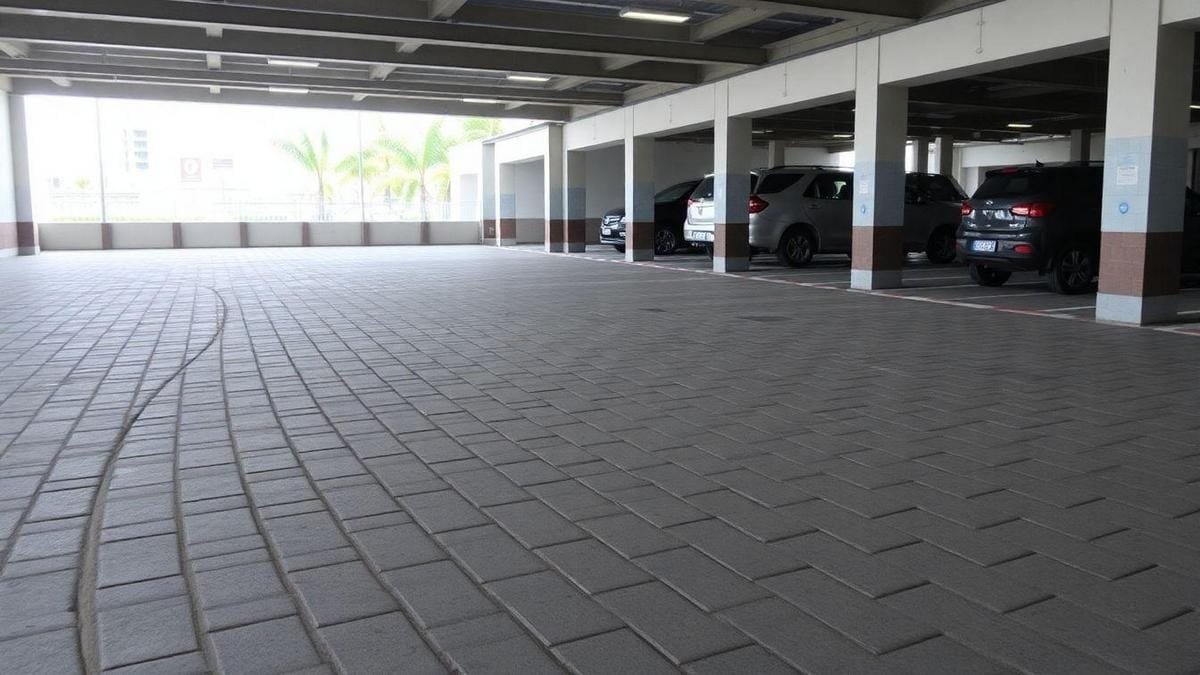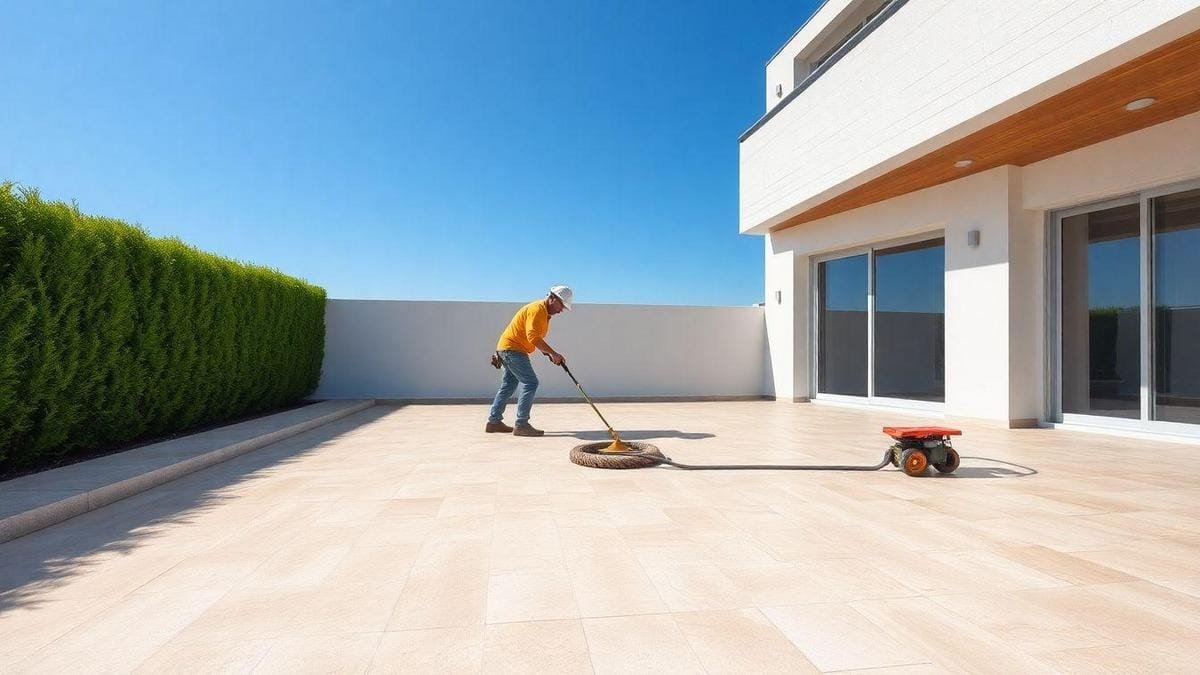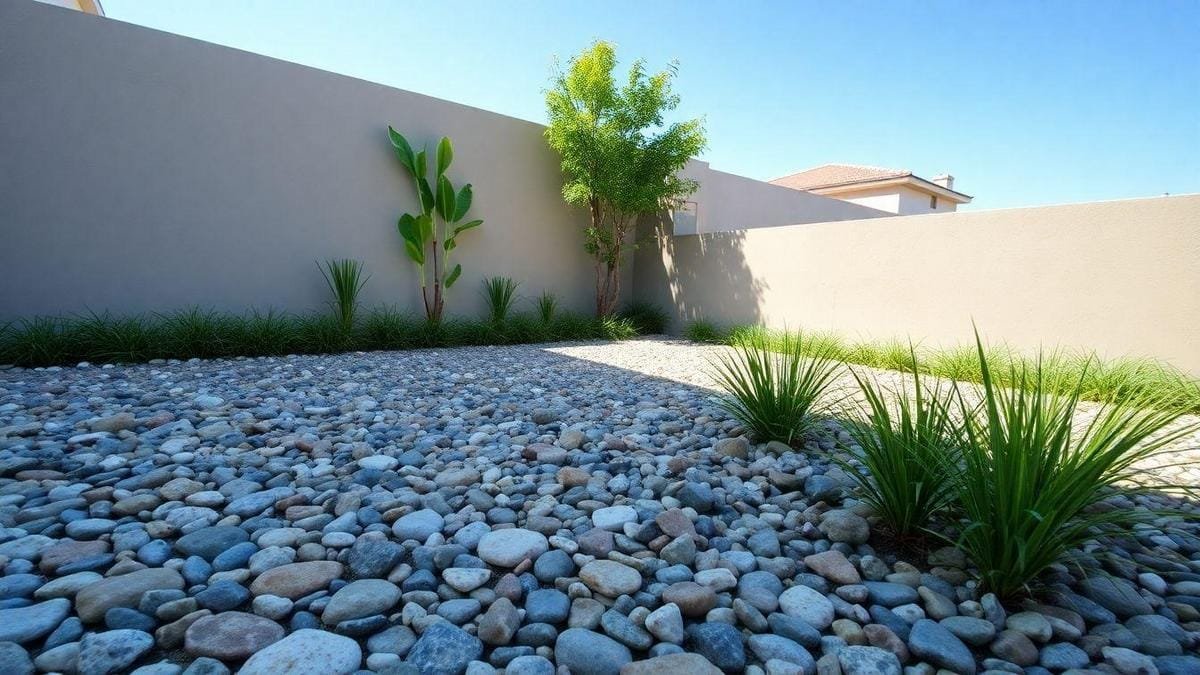Listen to this article
How to make interlocking floors for outdoor areas resistant is a fun and interesting task. In this article, you'll learn all about interlocking floorshow they work and what their advantages. Let's explore the materials that you can use, how to choose the best ones and even how to install your floor easily. What's more, you'll discover ways to look after your floors so that they're always beautiful and durable. Ready to find out more? Let's go!
Main conclusions
- Interlocking floors are easy to install.
- They help to make the place more beautiful.
- You can choose different colors and shapes.
- The water passes between the stones and does not form puddles.
- They are ideal for outdoor areas such as gardens and patios.

What are interlocking floors?
Definition of interlocking floors
The interlocking floors are concrete blocks that fit together like pieces of a jigsaw puzzle. They are used to make paths, sidewalks and even parking lots. These floors are very practical because they don't need mortar to stay in place. They hold together just because of the way they are made and how they fit together.
How they work
Interlocking floors work like a team of superheroes! Each block has a special shape that helps hold the others in place. When you place one block, it connects to the next and so on. This makes them very strong and stable. What's more, they allow water to pass through the gaps, helping to avoid puddles.
Advantages of interlocking floors
Here are a few advantages of interlocking floors:
- DurabilityThey last a long time, even in the rain and sun.
- Easy maintenanceIf a block breaks, you can replace it without having to do it all over again.
- AestheticsThey come in various colors and shapes, making the place look beautiful.
- SustainabilityThey help keep water in the soil, which is good for the environment.
| Advantages | Description |
|---|---|
| Durability | Resistant to different climates and intense use |
| Easy maintenance | Simple replacement of damaged blocks |
| Aesthetics | Various color and shape options |
| Sustainability | Allow water to infiltrate the soil |
Materials for making interlocking floors
Types of materials used
When you want to do interlocking floorsyou need to choose the right materials. Here are some common materials:
- ConcreteVery strong and durable, it is a popular choice because it can hold a lot of weight.
- CeramicsBeautiful and available in many colors, it is good for areas with little traffic.
- StoneNatural and adds a special touch to your space. Resistant, but can be more expensive.
- PlasticLightweight and easy to install, ideal for areas where you need something that won't break easily.
How to choose the best materials
Choosing the right material is like choosing the best toy! You need to think about a few things:
- UseWhat are you going to use the floor for? If it's for a place with a lot of traffic, concrete might be better.
- Style: Do you want your floor to look good? Ceramic tiles and stone come in many colors and styles.
- CostHow much can you afford? Plastic may be cheaper, but stone can be more beautiful.
- Maintenance: Some materials need more care. Concrete is easy to clean, while ceramic can break.
Comparison of interlocking flooring materials
Here is a simple table to help you see the differences between the materials:
| Material | Durability | Cost | Style | Maintenance |
|---|---|---|---|---|
| Concrete | Very high | Medium | Simple | Low |
| Ceramics | Average | High | Varied | Average |
| Stone | High | High | Natural | High |
| Plastic | Low | Bass | Varied | Low |
With this table, you can see which material might be best for you!

How to make interlocking floors for outdoor areas resistant
Step-by-step installation
Making interlocking floors is like putting together a puzzle! Here's what you need to do:
- Choose the place: Decide where you want to lay the floors.
- Prepare the soilRemove grass and dirt. The floor should be very smooth.
- Place a baseUse sand or crushed stone to make a firm base.
- Tidy the floorsStart laying the interlocking floors next to each other. They should fit together well.
- Fill in the gapsPut more sand in the spaces between the floors. This helps to keep everything in place.
- Tighten everythingUse a roller or rubber mallet to tighten the floors so they don't move.
Tools required for installation
To do all this, you'll need a few tools. Here's a list:
| Tool | What it's for |
|---|---|
| Shovel | To remove the soil |
| Squeegee | To spread the sand |
| Rubber hammer | To tighten the floors |
| Level | To make sure everything is straight |
Tips for a perfect installation
Here are some tips to help you do an incredible job:
- Work on a dry daySo the floor doesn't get soft and is easier to work on.
- Use a levelThis helps to keep everything nice and straight.
- Take your time: Take your time to avoid making mistakes.
- Ask for help: Get a friend or an adult to help you. It's more fun!
Maintenance of interlocking floors
How to care for interlocking floors
Taking care of interlocking floors it's very easy! You just need to follow a few simple tips. First, always clean up dirt and fallen leaves. This helps to keep the floor beautiful and stain-free. Use a broom or a hose to remove the dirt. If there are stains, you can use soap and water.
Here are some good tips for looking after your floor:
- Regular cleaning: Clean once a week.
- Remove dirtUse a broom or brush.
- Avoid strong productsDon't use chemicals that are too strong, they can damage the floor.
Recommended cleaning products
To make your floor shine, you can use a few products. Here are some that work well:
| Product | Type of use |
|---|---|
| Soap and water | Daily cleaning |
| Vinegar | For stains |
| Neutral detergent | Light cleaning |
These products are safe and help keep your floor looking beautiful. Remember to test any product on a small area first!
Optimal maintenance frequency
To keep your interlocking floors in top condition, clean them at least once a week. once a week. This will prevent dirt and stains from accumulating. If you notice that the floor is very dirty, you can clean it more often. Maintenance is like looking after a toy: the more you look after it, the longer it lasts!

Advantages of using interlocking floors
Durability of interlocking floors
The interlocking floors are very strong e resistant. They can withstand the weight of cars and trucks without breaking. This means that if you use interlocking floors, they will last for many years. You won't have to replace them every time, which is great news for your pocket!
Benefits for the environment
Using interlocking paving is good for the environment. They help absorb rainwaterand prevent the streets from flooding. It's like giving a glass of water to the earth! What's more, these floors can be made from recycled materials, helping to reduce waste.
Long-term savings with interlocking floors
When you choose interlocking floors, you're also thinking about saving money in the future. Here is a table showing how this works:
| Advantage | Economy |
|---|---|
| Durability | Fewer floor changes |
| Low maintenance | Fewer repair costs |
| Resale value | Increases the value of your home |
That's why using interlocking paving is a smart choice! You'll spend less money and help the planet.
Price and designs of interlocking floors
Price range for interlocking floors
The interlocking floors are a great choice for making your outdoor area beautiful and hard-wearing. But how much do they cost? Let's see!
| Floor type | Price Range (per m²) |
|---|---|
| Plain concrete floor | R$ 40 - R$ 60 |
| Decorated concrete floor | R$ 60 - R$ 100 |
| Ceramic flooring | R$ 80 - R$ 120 |
| Natural stone flooring | R$ 100 - R$ 200 |
Prices can change, so it's always a good idea to search e compare. So you can find the best deal for your pocket!
Styles and designs available
Interlocking floors come in many styles e designs! Here are a few you can choose from:
- Concrete floorsVery strong and available in various colors.
- Ceramic tilesBeautiful and easy to clean.
- Stone floors: They give a natural and beautiful touch.
How to choose the right design for you
Choosing the right design for your space can be fun! Here are some tips:
- Think about the placeIs the floor going to be in a place that gets wet a lot? Then choose one that won't slip!
- Match the house: If your house is colorful, choose a floor that matches. If it's simpler, a decorated floor might be nice!
- Ask for helpIf you don't know which one to choose, ask someone who knows flooring for help.
Conclusion
Now that you've learned all about interlocking floorsit's time to get down to work! These floors are easy to install, beautiful e resistant. With the tips you've received, you can make a beautiful outdoor space like a true artist! Remember to take good care of your floor, so it will shine for a long time. And if you want to find out more about renovations and great tips, be sure to visit the website Renovation Tips. Let's make the world more beautiful together!
Frequently asked questions
What are interlocking floors?
Interlocking floors are blocks that fit together. They form a beautiful and durable floor.
How can I tell if interlocking flooring is good?
You can check the quality. It should be sturdy and look good.
What materials are good for making interlocking floors?
You can use concrete or tiles. These materials are strong and durable.
How do I prepare the place where I'm going to lay the floor?
First, clear the land. Then level the ground. This will make it easier.
What kind of base do I need for interlocking floors?
You need a gravel base. This helps drain the water and provides support.
How difficult is it to lay interlocking floors?
It's not very difficult. With a little practice, you can do it.
How long does it take to make interlocking floors?
It depends on the size of the area. It can take a few hours or even a day.
Can I make interlocking floors myself?
Yes, you can! With the right tools and patience, you can.
How do I make the floor last longer?
You need to clean and maintain it. Avoid leaving dirt and standing water.
Can interlocking floors be slippery?
If placed correctly, they shouldn't slip. Choose a good texture.
How can I learn more about how to make interlocking floors for outdoor areas resistant?
You can search for videos and tutorials on the internet. They teach you step by step!
Do I need special tools?
You'll need a few tools, such as a spade and a level. Not many!
What do I do if the floor breaks?
You should replace the broken piece. That way, your floor always looks beautiful and strong.

Adalberto Mendes, a name that resonates with the solidity of concrete and the precision of structural calculations, personifies the union between engineering theory and practice. A dedicated teacher and owner of a successful construction company, his career is marked by a passion that blossomed in childhood, fueled by the dream of erecting buildings that would shape the horizon. This early fascination led him down the path of engineering, culminating in a career where the classroom and the construction site complement each other, reflecting his commitment both to training new professionals and to bringing ambitious projects to fruition.

